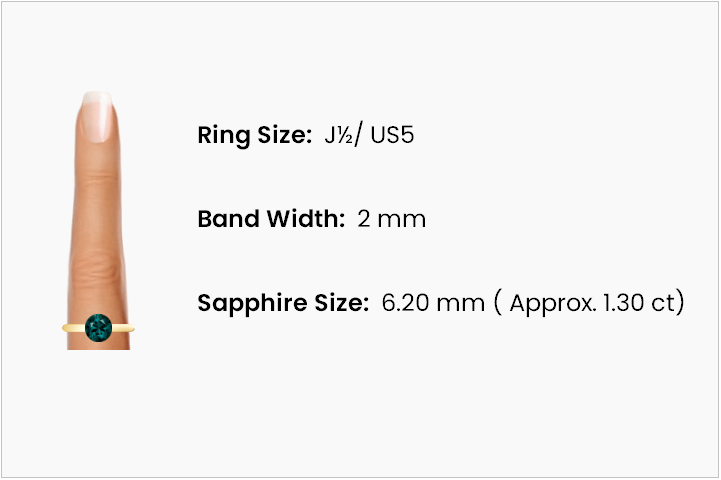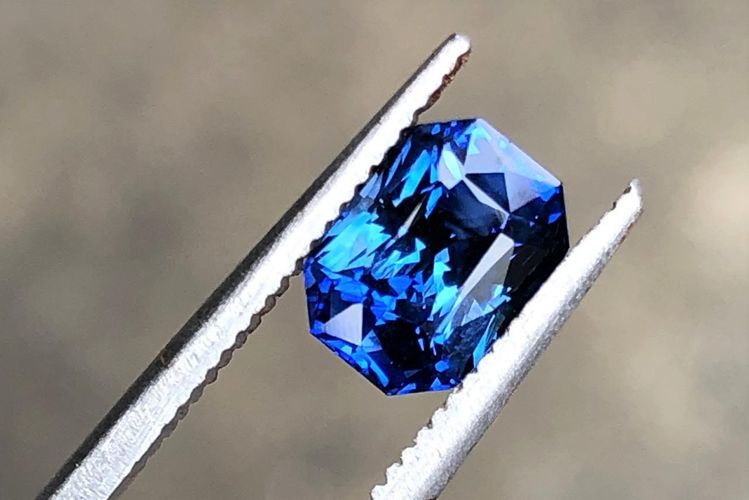If you’re looking to stand apart from the crowd, then you may be considering a sapphire as a centre stone for your engagement ring, here are the 5 most important factors to take into consideration when evaluating sapphires.
1. Colour

The overall value of a sapphire largely depends on its colour, so it’s an important aspect to consider whilst judging and choosing a sapphire. Instead of a colour scale, the overall colour of a sapphire depends on its hue, tone and saturation.
Hue – Hue is the overall body colour of a sapphire and is usually the first colour that you identify when you look at a sapphire. It is not uncommon to find sapphires with more than one hue. For example, a teal sapphire will have a secondary hue of either blue or green, depending on the proportion of the colour mix.
Tone – Quite simply, the tone describes how light or dark the main hue of the sapphire is. Whilst preference of tone varies from person to person, it is usually sapphires with a medium-dark tone that are preferred. Dark tones can be considered too ‘inky’ as they make the sapphire look dim and opaque once set in the ring.
Saturation - Saturation refers to the strength or weakness of a colour in a sapphire. Regardless of their main colour, it’s the sapphires with vivid, highly saturated colours with no dilution that are typically the most prized.
TIP
A sapphire’s colour can look different in a studio setting with improper lighting. Always ask for video taken in both indoor and outdoor environments so you can better judge the stone’s actual colour.
2. Cut

It is the cutting parameters of a sapphire that define the overall brilliance and sparkle. Unlike diamonds, there are no standard cuts for sapphires and instead, each individual sapphire is custom cut to bring out the best display of colour, brilliance and lustre.
If a rough sapphire has a lighter tone of colour, the gem cutter will cut the sapphire deeper in order to retain the maximum amount of colour. Similarly, a rough sapphire of a very dark colour is usually cut shallower to allow more light to enter, thus reducing the darkness of the sapphire colour. Both approaches enhance the overall appearance of the sapphire.

WINDOW
When considering a sapphire, it’s important to keep an eye out for ‘windows.’ Windows occur as a result of the sapphire being cut too shallow, thus enabling the light to escape the sapphire instead of being reflected back to the eye.
Windowing is a result of poor cutting so sapphires with a window should be avoided as the overall brilliance of the sapphire will be reduced.
3. Carat

Carat is often used to refer to the size of a gemstone but in actual fact represent the weight of the stone.
Compared to diamonds, sapphires have a higher gravity. So visually, a 1.00 carat round diamond will look similar to a 1.40 carat round sapphire.
Apart from higher gravity, all sapphires have a personalised cut with either shallow, medium or deep cuts hence even similar carat weight sapphires can look visually different in appearance.
Given that the size of the ideal centre stone and ring finger is relative to each other, when contemplating what the ideal mm size or carat weight is, bigger may not always be better. For example, if your partner has a small finger size (I - M), a round sapphire between 1.00 and 1.50 carats would look suitably proportioned.
Due to the cutting proportions, pear and marquise shaped sapphires look much bigger than other shapes. For example, a 1.00 carat pear cut sapphire would look like a 1.50 carat oval sapphire and a 1.00 carat marquise-cut sapphire would have a similar length to a 2.50 carat oval sapphire.


4. Clarity

Contrary to popular belief, clarity does not mean how far we can see into a sapphire. Where sapphires are concerned, clarity refers to the amount of inclusions, also known as impurities, that are found within a gemstone.
A natural characteristic of sapphires, inclusions are nearly impossible to avoid. However, inclusions that are usually only visible from a 7x loupe will not affect the overall appearance of a sapphire. With both quality and affordability in mind, it is usually best to choose a sapphire that is ‘eye clean’, meaning that no inclusions can be detected with the naked eye.
TIP
Sapphires are commonly graded as A, AA or AAA in the industry. In our experience, there is no standard definition for any of these, so it’s always a good idea to ask your vendor what AAA means to them.
5. Enhancements

For centuries, gemstones have been treated in order to improve their colour, clarity and lustre. The way in which a sapphire is enhanced can directly affect its overall value. Apart from standard heat treatment, no other treatments offer permanent enhancement, so add no value when compared to natural (heated or unheated) sapphires.
FAQs
Are heated sapphires valuable?
Absolutely, fine sapphires with excellent colour, lustre and clarity being rare, even though they are heated, they can cost in 10s of thousands of dollars depending on their exact colour.
For example, a heated 2.00 carat round blue sapphire can range between US$2,550.00 ~ US$3,750.00 whereas an unheated 2.00 carat round blue sapphire can be anywhere between US$3,150.00 ~ US$4,650.00
What percentage of sapphires are heat treated?
It is estimated that over 98% of the sapphires available in the market are heated to some degree.
Is heat treatment permanent?
Yes, the heat treatment is permanent and does not affect the overall integrity, structure and durability of the sapphire.
